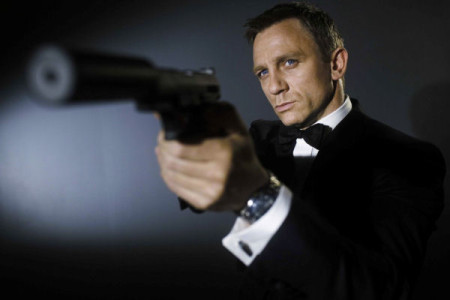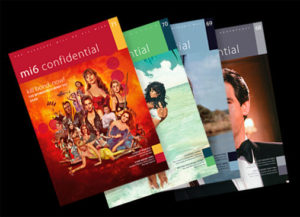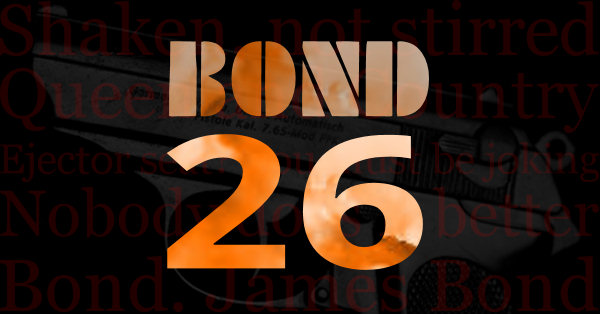Le Chiffre is angry. Humiliated and frightened for his life, he wants James Bond to give him the password to his account to retrieve what’s rightfully his. Tying him to a chair, he directs his electric robot towards a tuxedo clad Pierce Brosnan,whose Omega and iPod are clearly visible…

Thankfully, Casino Royale did not turn out that way, otherwise there would be a lot more angry fans out there than there were following the release of Die Another Day (2002).
The fortieth anniversary film had the potential to be a great one – yet it squandered its potential for a trashy Madonna title track and a plot more focused on making nods and winks at the previous nineteen movies than it did pushing the storyline forward.
Die Another Day was awful. It made buckets of money, sure, but it was awful. Pierce Brosnan publicly slated the picture. Michael G Wilson later politely claimed that they went too far with the gadgetry. Hell, Roger Moore, the star of Moonraker and Octopussy, thought the film was too far-fetched! Invisible cars, questionable CGI and product placement ad nauseum left the Bond franchise a fragment of its former glory.
With Paul Greengrass and Christopher Nolan developing grittier fantasy adventures, Bond had to change to keep up with the times. To truly show their commitment, Brosnan (hopeful for a fifth film) was told he was no longer wanted. It soon transpired Liverpudian actor Daniel Craig was.
It’s easy to forget in 2015 how grand the furore was over Craig’s initial casting was in 2005. A blond BOND! Heaven forbid an unintelligible Scots man and a foxy haired lothario had both played the part for seven successful films. Those who criticised him slated his lack of style for the role, ignoring the seamless cool Craig projected in Layer Cake and Munich and the emotional depth displayed in Our Friends In The North.
All nonsense.
Craig turned out to be an exceptional choice. No other Bond, save George Lazenby, proved as physically capable of breaking people’s necks in reality as he did on screen. No other Bond, save Timothy Dalton, had the acting chops to show James Bond at his darkest moments.
He could both run over a crane at breakneck speed and break your heart in the middle as he stares at himself irately following his cold blooded murder of Steven Obanno, with a hardened sense of humour different to Moore’s or Brosnan’s.
Constantly bruised, bloodied and battered, Craig’s Bond is far from the superhero of the seventies, giving an authenticity the series had never dared tread. Only once in the entire film does he slip up, when he tells Vesper that he loves her, his display coming across as a dialogue worthier of a soap opera than classic espionage, but the fault is as much a fault of the writers as the actor. Later, he spurns “the bitch is dead” with such calculated cool and menace, he single handled forgives such a blunder made fifteen minutes earlier. All in all, is one of the more stand-out performances within the Bond canon.
But a star cannot make a great film on their own (watch Sean Connery’s insipid Never Say Never Again for proof). The stunts, the music, the supporting cast, the production design – it all has to be taken into account. Re-hiring Martin Campbell proved an inspired choice, not least because Goldeneye was the only watchable Pierce Brosnan film. Campbell brings with him a flair to the film, shot after shot comes easy to him: Guy Hamilton and Lewis Gilbert could handle style, John Glen and Marc Foster could film gritty action, Campbell does both with ease, something only Terence Young and Peter Hunt could do (though the jury is still out with Sam Mendes, SPECTRE might put him in that pantheon).
The Bahamas are as gorgeous as any travel documentary could paint them, the later Casino scenes evocative of cinema both classic and contemporary. Keeping audience attention over a forty minute card game is no easy feat, but Campbell keeps the film rolling with a nifty fist fight, a noxious poisoning in a glass and the necessary intellectual foreplay between hero and villain. Alfred Hitchcock himself could hardly do better!
Judi Dench (although a continuity irritant), gives what may be her best performance as M. Where Skyfall tried to throw out themes of maternal protection, Royale does it in a much subtler and effective manner. Jeffrey Wright is a lean, mean Felix Leiter, and few people could look as friendly, yet so dangerous riding a horse as Caterina Munro does.
Mads Mikelsen is terrific, Le Chiffre a wonderful platform for which to perfect his later portrayal of cinema’s favourite cannibal. While weedy in appearance, his intellectual capacity is never in doubt; where most villains treat Bond like a long lost relative, Le Chiffre shows his true venomous side by physically thumping a nude Bond in an area most men would risk everything else to protect. Such vulnerability is rare in a Bond film, but Mikkelsen pulls it off without losing his tenacity to keep his cool.
But it’s Eva Green who’s the true scene stealer. Although she was only in her mid twenties at the time of filming, Green brings with her a sense of class, ethereality and humanity of a much older actress. Whatever Bond can deliver, Green’s Vesper Lynd can deliver twice as much.
The most well developed romance since The Living Daylights, On Her Majesty’s Secret Service even, Lynd’s suicide is a particularly harrowing watch, knowing Bond has not just lost a bit of rump, but a human being, one who stripped his armour away.
Green, a terrific actor, gives the character dimensions, not too dissimilar to Helen Mirren in The Long Good Friday. Strange to think a mere seven years earlier, Denise Richards’ was their choice of preferred Bond Girl! Bond really has met his intellectual match in Lynd.
A special mention must be addressed to David Arnold, who’s score here outshines any of his other Bond work, ironic, given that it only uses the Bond theme at the very end of the movie!
Arnold’s masters his tricks by placing motifs and semi-motifs here and there, some distinctly Bondian notes to show his progression throughout the film, while his composition for the Death of Vesper has to be the most stirring heard since Bond proposed to Tracy in 1969. A return to the classical style of recording, Arnold’s score use of horns adds to the film’s continuing and evolving drama.
The most satisfying adventure since On Her Majesty’s Secret Service, Royale proved what many thought impossible. It made Bond real again, more than a cliché ordering martinis, more than a model for Brioni.
Where Die Another Day had been a romp of references glittered from shot to shot, Royale succeeded by ignoring everything Bond had once stood for, instead focusing on what he was standing for. Without Royale would there be Bond 24?
Most likely. But would the world be waiting with baited breath for SPECTRE were it not for Royale?
To the film that saved the franchise!











August 29th, 2015 at 15:42
Excellent article! Whilst I don’t agree with every point, (I happen to like Brosnan and the Bond/Vesper love conversation), I enjoyed reading your point of view. CR really is one of the best Bond films and is a great film, period. I think Campbell is far more effective and more of a consummate filmmaker with this entry than Goldeneye and was shocked how his Green Lantern turned out.